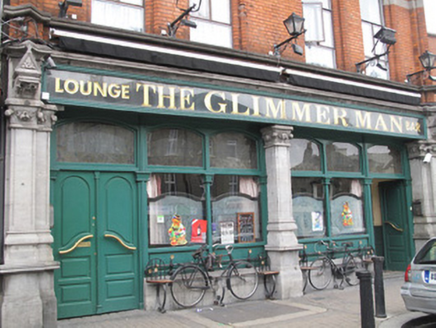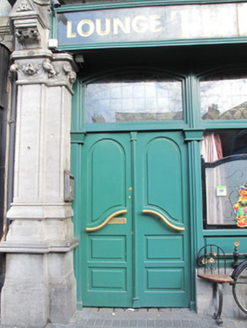Survey Data
Reg No
50070187
Rating
Regional
Categories of Special Interest
Architectural, Artistic, Historical, Social
Previous Name
T. Lyster
Original Use
Public house
In Use As
Public house
Date
1870 - 1890
Coordinates
314450, 234756
Date Recorded
13/10/2012
Date Updated
--/--/--
Description
Attached four-bay three-storey public house, built c.1880, having shopfront to front (west) elevation. M-profile pitched slate roof with carved limestone coping, red brick chimneystacks and red brick parapet having carved limestone coping to front. Red brick walls laid in Flemish bond with red brick buttresses surmounted by carved limestone gargoyles. Cut limestone platbands. Paired square-headed window openings with stepped chamfered reveals, brick voussoirs, red brick and limestone arch rings and carved limestone panels. Continuous carved limestone sill courses. Replacement uPVC windows. Shopfront comprising carved limestone piers having foliate capitals and gabled consoles, carved limestone cornice over timber-framed glazed fascia. Square-headed openings to shopfront comprising timber framed paired window openings with segmental-headed coloured glass overlights, timber risers over limestone plinth course, and double-leaf timber panelled doors to either end. having coloured glass overlights. Tiled floor to lobby, with “T, LYSTER” in terrazzo. Some original granite paving to front surrounding steel door to basement area.
Appraisal
Attributed to J. J. O’Callaghan, this elegantly-proportioned building makes a strong impression on the streetscape. Elaborate stone detailing, to the upper floors as well as to the shopfront, enliven the façade and add textural interest to the streetscape. Carved capitals and gargoyles are testament to the skill and craftsmanship of stonemasons in the later decades of the nineteenth century, as well as the interest in Gothic revival motifs at the time. The steeply pitched roof is another Gothic revival feature and makes a positive contribution to the streetscape. Stoneybatter was one of the approaches from the north to the fair in Smithfield, which led to the large number of public houses on this street.

























